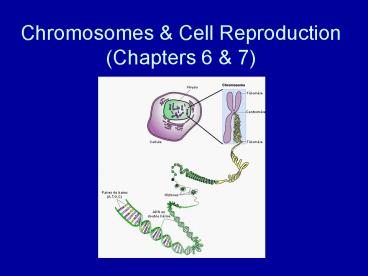Chromosomes - PowerPoint PPT Presentation
1 / 24
Title:
Chromosomes
Description:
Chromosomes & Cell Reproduction (Chapters 6 & 7) – PowerPoint PPT presentation
Number of Views:143
Avg rating:3.0/5.0
Title: Chromosomes
1
Chromosomes Cell Reproduction(Chapters 6 7)
2
- I. Cell Division produces new cells from parent
cells each new cell has a copy of the DNA - A. Why do cells divide?
- 1. growth and development
- 2. repair
- 3. reproduction
3
- B. Types of Cell Division
- Binary Fission occurs in prokaryotes (i.e.
bacteria) - a) asexual reproduction 1 parent cell
- splits into 2 identical offspring
- b) single, circular DNA
4
(No Transcript)
5
- 2. Mitosis occurs in
- eukaryotes
- a) takes place in
- somatic cells
- (body cells
- not sperm/egg)
- b) a copy of DNA
(chromosomes) are - passed on to the
- newly formed cells
6
- C. DNA and Chromosomes
- 1. DNA nucleic acid
- genetic information
- (the code)
- 2. gene segment of
- DNA that codes
- for a characteristic
7
- 3. chromosome DNA proteins coiled into a
single structure - 4. chromatids two exact copies of a
chromosome attached at the centromere - separate during cell division
8
- Each species has a unique of chromosomes
- 1. see Table 6-1 page 121
- 2. Humans 46 chromosomes
9
a) 23 homologous chromosome pairs ?
homologous chromosomes - similar
size, shape, and genes in same
location ? one chromosome in each pair is
donated from each parent (23 from
mother 23 from father) ? 44
autosomes (22 autosomal pairs) and
1 pair of sex chromosomes (XX female and XY
male)
10
Autosomes
Sex chromosomes
11
- b) Somatic cells are diploid (2n)
- have both sets in a homologous pair
- (humans 2n 46 chromosomes)
- c) Gamete cells are haploid (n)
- have only 1 set one of the chromosomes
- from each pair (humans n 23)
- ? Gametes sperm (n 23) egg (n 23)
12
- ? Zygote egg sperm join (fertilization) in
sexual reproduction
13
- 3. Karyotype photo of chromosomes in a dividing
cell a) can reveal - chromosomal
- disorders
14
b) Types of chromosomal disorders 1)
non-disjunction too many
chromosomes (fail to separate) ex
Downs Syndrome trisomy-21
(extra 21st
chromosome)
15
- 2) duplication repeat
- 3) deletion missing
- 4) inversion backwards
- 5) translocation on a different
- chromosome
16
II. The CELL CYCLE
17
Checkpoints
18
Cancer
- Uncontrolled division of cells
- 2 types of tumors (cell masses)
- Benign
- remains at original site
- Can be removed surgically
19
- Malignant
- Cells spread to other locations (metastasis)
- Treated with chemotherapy radiation
- New experimental treatments with gold
nanoparticles
20
III. Mitosis
21
IV. Meiosis
- A. Forms haploid cells (gametes) for sexual
reproduction - B. Cuts the chromosomes in half
- 1. Haploid (n) 23 for humans
- 2. Sexual reproduction requires fertilization
- ovum (egg) sperm fuse ? diploid (2n) zygote
- 23 23
46
22
- C. Two nuclear divisions after interphase (G1, S,
G2) - D. Mechanisms of genetic variation
- 1. independent assortment
- 2. crossing over
- 3. random fertilization
23
(No Transcript)
24
(No Transcript)































